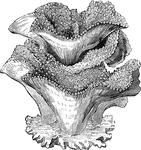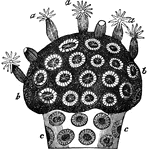Clipart tagged: ‘hellianthoida’

Astraea rotulosa
"It is to this family more especially that the formation of the coral reeds is to be attributed. In…

Tree-coral
"These animals are generally called Tree-corals, on account of the forms of the polypidons…

Astrae virdis
"a a, expanded polypes; b b, polypes withdrawn into their cells; c c, coral uncovered by flesh, showing…